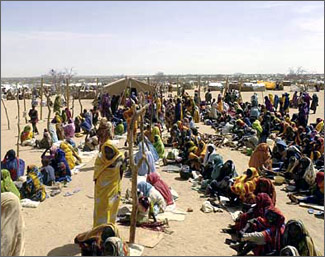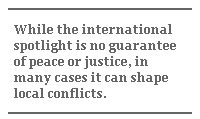Marketing Humanitarian Crises
Marketing Humanitarian Crises

PITTSBURGH, PA: In summer 2004, as the Darfur crisis edged into the world’s consciousness, UN Under-Secretary General for Humanitarian Affairs Jan Egeland made a striking admission. Pondering why Darfur had suddenly attracted international interest when other bloody conflicts had not, Egeland told “The New York Times”: "I don't know why one place gets attention and another not. It's like a lottery, where there are 50 victimized groups always trying to get the winning ticket, and they play every night and they lose every night. I myself have said that the biggest race against the clock is Darfur, but in terms of numbers of people displaced, there are already more in Uganda and the eastern Congo."
Egeland’s perplexity is shared by many: Why do a few issues electrify the press and galvanize nongovernmental organizations (NGOs), while most others fail to elicit international concern? Why, for instance, did Mexico’s 1994 Zapatista rebellion catalyze a vibrant international support network, when longstanding indigenous activism across Latin America created no such response? Why have the Tibetans amassed worldwide backing when the Uighurs – another Chinese minority of like size, facing analogous threats, and making similar claims – remain far less celebrated abroad?

These questions are not just academic. Press attention and NGO activism can alter the dynamics of conflict. Expanded resources, experienced activists, and new contacts with key policymakers can strengthen dissident movements and pressure repressive governments or negligent multinationals to improve their records. While the international spotlight is no guarantee of peace or justice – witness Darfur – in many cases it can shape local conflicts.
In explaining disparities in international concern, Egeland’s “lottery” theory no doubt holds some truth: Luck plays a role in many social phenomena. But deeper analysis reveals an underlying rationality. Unfortunately, this does not take the form of a “meritocracy of suffering,” as suggested by some scholars and NGO staff. In this rosy view, vigilant journalists would persistently report on the world’s “hot zones”; selfless NGOs would tirelessly scour the globe for the “neediest cases”; Internet websites would instantly provide access to virtual victims; morality and principle would reliably explain who gains support; and sustained overseas activism would usually ameliorate distant suffering.

The reality is different. Even cursory observation shows that many of the world’s worst problems remain off the international agenda. Civil and inter-state war in the Congo since the mid-1990s has scarcely registered overseas, notwithstanding millions of deaths. For much of the 1980s and 1990s, Sudan’s North-South confrontation, with similarly horrific casualties, also remained little known. In recent decades, smaller-scale conflicts and human rights violations from Mauritania to Indonesia to Colombia, have likewise remained relatively invisible outside their home states despite large human losses.
Yet, while a “meritocracy of suffering” remains illusory, there is logic, albeit a more cold-blooded logic, to the distribution of international concern. Gaining attention is far from easy. At any one time, numerous wars, massacres, famines, and diseases vie for notice. The competition may be indirect: Seldom does one needy group malign another. And sometimes attention to one victim helps others nearby or bearing similar grievances elsewhere. But competition is nonetheless real.
The main reason is that resources devoted to international issues are simply too small to meet the needs of the world’s poor, diseased, and conflicted. Even the largest NGOs complain of too few funds – and constantly campaign for more. For its part, the United Nations annually highlights a handful of “forgotten crises.”

In this context, NGO support is best conceived not simply as altruism but also as exchange. On one side are myriad victims desperate for support, on the other NGOs with meager but critical resources. This creates a lop-sided power relationship strongly favoring NGOs. While many have good intentions, NGOs carefully choose where they devote their scarce money, personnel, and time. In addition, they have internal needs – pleasing funders and constituents while sustaining and expanding their organizations. Therefore, NGO views of what constitutes a major problem, NGO predilections for certain tactics, and NGO demands for accountability – themselves a reflection of Northern perspectives or fads – profoundly shape the field on which needy groups compete for support.
Not surprisingly, the victims most likely to gain are those whose profiles most closely match NGO preferences – not necessarily the most desperate. In some cases, NGOs will search out distant clients who epitomize an ongoing campaign, as happened in the late 1990s when Sudan finally rose to the international agenda on a wave of organizing by powerful Christian-based constituencies in the U.S. For these activists, a war in which northern Muslims repressed and enslaved southern Christians was not only criminal; it also served as a potent symbol for broader concerns, making religious-based persecution a core human rights issue and boosting religion’s role in American foreign policy.

But, while the southern Sudanese were eventually “discovered” by overseas allies, most local aid-seekers must sell themselves. In this, marketing matters considerably. While there are numerous strategies, all aim to raise international awareness and enhance a group’s appeal to distant NGOs. With email, websites, cellular phones, and personal lobbying, those facing persecution use every available means to publicize their cause. In the welter of competing claims, many turn to protest or force to attract notice. This was a key Zapatista strategy, invading a major Mexican city, then using the resultant media frenzy to project the Indians’ plight overseas. In this, the Zapatistas affected CNN and other media as much as the “CNN effect” helped them.
But winning attention is only half the story. Many groups must reframe their claims, tactics, organizational practices, and even their identities to fit the concerns of foreign audiences. The Tibetans’ international reputation as a uniquely spiritual people owes much to these requisites. Reciprocally, outside audiences often insert their own visions into local struggles having quite different ends. India’s Chipko movement, perceived internationally as an environmental cause in which tree-hugging indigenous people opposed harsh state development policies, was in fact grounded in longstanding claims for a new state to be carved out of Uttar Pradesh.
Victim groups differ in their ability to deploy marketing strategies, with economic, educational, and organizational inequalities systematically favoring some over others. Those from high-profile countries, especially those having pariah regimes or notorious leaders; those with superior resources; and those with pre-existing international contacts hold the upper hand compared to similarly oppressed groups that, through historical or geographical accident, lack such advantages. In this context, a leader skilled in English, educated in a Northern university, or familiar with NGO repertoires can make a crucial difference. Mexico’s Zapatista rebels are a case in point. Composed of a few thousand poor, indigenous peasants, the Zapatistas benefited greatly from their outsider spokesperson. Subcomandante Marcos, a polyglot ladino and gifted communicator, was crucial to the Zapatistas’ spurring foreign solidarity.
In sum, the allocation of international activism has logic. But, contrary to the despair of Jan Egeland and the optimism of NGO cheerleaders, it is grounded in vast differences in power between NGOs and the needy groups they selectively assist. In this context, local groups are far from helpless. Marketing matters - but only a fortunate few will gain major support.
Click here to read an excerpt from Clifford Bob's book, “The Marketing of Rebellion: Insurgents, Media, and International Activism.”
Clifford Bob, assistant professor of political science at Duquesne University, is the author of “The Marketing of Rebellion: Insurgents, Media, and International Activism,” published by Cambridge University Press in 2005. This article is based on the book.